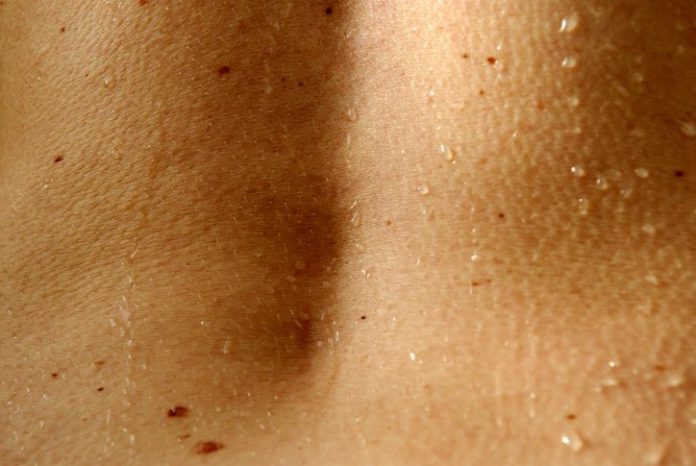What is hyperpigmentation?
During pregnancy up to 90% of women experience some degree of darkening to areas of the skin. This darkening of the skin is referred to as hyperpigmentation. This may occur in specific areas of the body such as the midline of the tummy as in ‘linea nigra’ or on the face as in ‘the mask of pregnancy’ also known as melasma. Alternatively, the darkening of the skin may affect skin spots such as scars and freckles, may affect the nipples and area around the nipple (the areola), the external genitalia, or areas of increased friction including the arm pit (axillae) or the inside of the thighs (groin).
More information on Linea Nigra
More information on ‘The mask of pregnancy’
Am I likely to develop hyperpigmentation?
Approximately 90% of pregnant women will experience some form of skin darkening (hyperpigmentation) during their pregnancy.
Women who are dark haired and have dark complexions are more likely to develop some degree of skin darkening, and it is also more likely to be more pronounced in these women also.
Why does it occur?
The exact cause is not known but it is thought to occur due to increased levels of hormones produced in pregnancy. These include:
- Melanocyte stimulating hormone – a hormone that stimulates melanocytes – the cells in the body that produce pigment and give rise to darker skin, freckles, birthmarks (naevi) etc.;
- Oestrogen; and
- Progesterone.
When does it occur?
Hyperpigmentation tends to develop in the first trimester of pregnancy and it is considered as one of the earliest signs of pregnancy.
However, in first pregnancies its appearance may be delayed until several months into the pregnancy.
How long does the hyperpigmentation last?
The increased pigmentation can continue to progress during the pregnancy until delivery.
The darkened areas almost always lighten following delivery of the baby, however, this may take months and in some women it will not completely fade.
In subsequent pregnancies it may appear earlier and darker than previously.
What can I do about the darkened areas?
 The darkened areas that developed in your pregnancy will generally fade following the delivery of your baby. Preventative measures and treatment options are limited.
The darkened areas that developed in your pregnancy will generally fade following the delivery of your baby. Preventative measures and treatment options are limited.
It is recommended that pregnant women wishing to minimise skin darkening use sunscreen on sun exposed areas, wear appropriate protective clothing, avoid sunbathing and excessive sun exposure.
Current Australian skin cancer prevention campaigns recommend that individuals use sun protection such as hats, clothing, sunscreen, sunglasses and/or shade during periods when UV index is high, typically between 10am and 3pm. Given that the sun is a major source of vitamin D, essential for bone health, there needs to be a balance between exposure and protection. The amount of sun exposure you need to prevent vitamin D deficiency varies depending on your skin type, location, season and time of day. Generally 30 minutes of sun exposure to the neck, hands and arms when the UV index is low gives sufficient exposure to maintain vitamin D levels for Australians. This is something that you can discuss with your General Practitioner as it will also vary depending on your individual risk factors for skin cancer and vitamin D deficiency.
The skin changes brought about by the increased levels of hormones in pregnancy are not associated with the development of skin cancer. However, if you have developed these skin changes from increased sun exposure you may be at risk of developing a skin cancer not related to these skin changes given that sun exposure is a risk factor for the development of skin cancer. There is no strong evidence that pregnancy is associated with changes in naevi (moles). Therefore if you have a mole that has changed in its appearance it should be looked at by your General Practitioner. If suspicious for a cancer, your General Practitioner can arrange for a biopsy of the mole.
There are multiple creams/lotions that can be used to help reduce the skin changes. These are typically prescribed by doctors who specialise in the treatment of skin conditions (called dermatologists). Treatment is usually only used in those women in which the skin changes do not resolve spontaneously following delivery of the baby and are troublesome for the mother. Treatment is not recommended during pregnancy for several reasons:
- The hormones that are the cause of the skin condition persist during pregnancy, and hence it is harder to treat;
- Most cases resolve on their own once the baby is born, although this may take some months; and
- The treatments used can be harmful to the developing baby.
During your pregnancy or after the birth of your baby, you can consider camouflaging the skin changes with cosmetics. Foundations and powders with a white or yellow undertone can minimise the appearance.
If the areas fail to fade following the delivery of your baby, you may want to discuss this with your General Practitioner who may be able to advise you further on treatment options or may refer you to a doctor who specialises in the treatment of skin conditions (a dermatologist). Depending on the area involved, treatment options may include:
- Creams such as hydroquinone, tretinoin and/or fluocinolone acetonide
- Chemical peels
- Dermabrasion
- Laser therapy
Kindly written and reviewed by Dr Allison Johns BSc (Hons) MBBS, Doctor, King Edward Memorial Hospital and Editorial Advisory Board Member of Parenthub and Virtual Medical Centre.
References
- Ingber, A. Obstetric Dermatology: A practical guide. 2009. Springer-Verlag, Berlin Heidelberg.
- Black, M (ed). Obstetric and Gynaecologic Dermatology. 3rd Edition. 2008. Elsevier, China.
- Adekunie OG, Olaylwala BS, Eokezie E, Mitchell W, Olufemi K. The Incidence of lower mid-trunk hyperpigmentation (linea nigra) is affected by sex hormone levels. Journal of the National Medical Association 2005; 97: 685-688. (Full text)
- Stalgis-Bilinski KL, Boyages J, Salisbury EL, Dunstan CR, Henderson SI, Talbot PL. Burning daylight: balancing vitamin D requirements with sensible sun exposure 2011; 194:345-348. (Full text)
- Clinical Practice Guidelines for the management of melanoma in Australia and New Zealand: Best practice guidelines (online). Australian Cancer Network. October 2008 (cited 15 October 2012). Available from: URL link
- Melasma: tips for managing. American Academy of Dermatology. Online (cited 28 September 2012). Available from: URL link
- Schalock PC, Isu JTS, Arndt KA (eds). Lippincott’s Primary Care Dermatology. 2010. Lippincott Williams & Wilkins.



 (10 votes, average: 4.30 out of 5)
(10 votes, average: 4.30 out of 5) 






